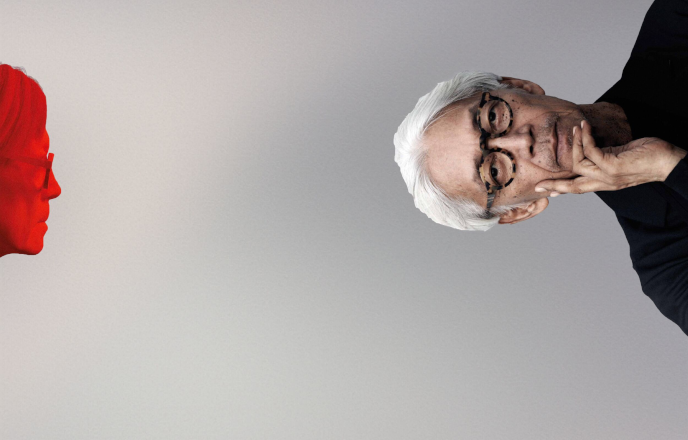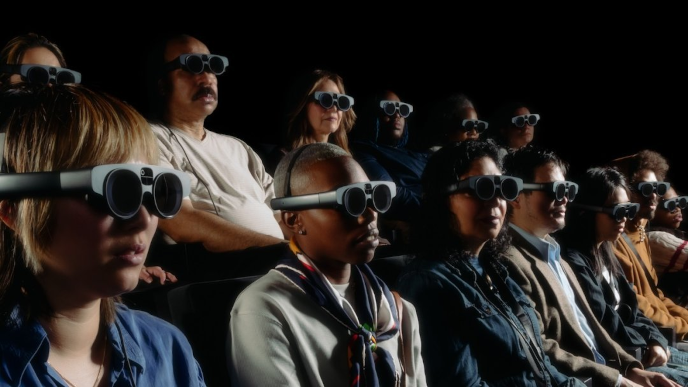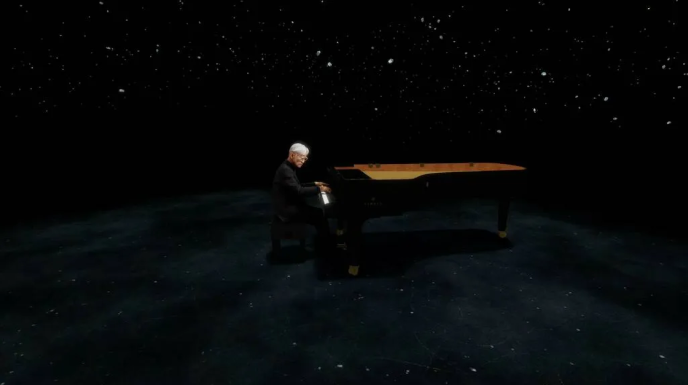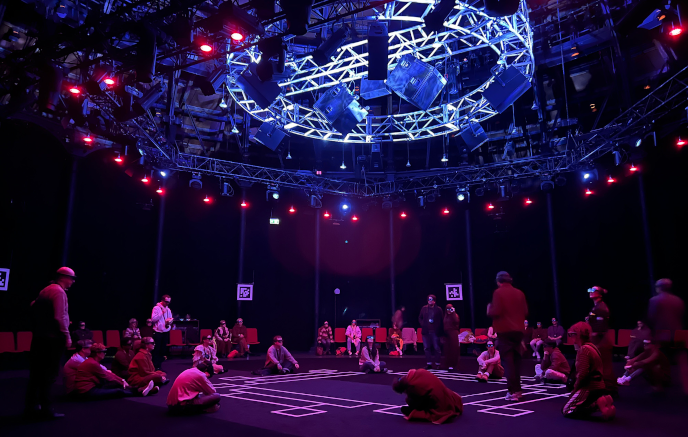What if you could t-pose Ryuichi Sakamoto?

Kia ora koutou katoa and welcome back to Post-Electric, a newsletter about theatre and culture in the age of the profit-driven blackout. This week’s newsletter is the first longer response, looking at Tin Drum’s ‘mixed-reality’ collaboration with Ryuichi Sakamoto, Kagami, and the idea of mixed-reality work as a meaningful shift in how we as audiences interact with art.

What if you could t-pose Ryuichi Sakamoto? Kagami, kitsch, and audience 'agency' in mixed-reality
I bought my ticket for Kagami (@ Roundhouse, London, 30/12/23) not really knowing much about Ryuichi Sakamoto. Unlike a lot of people who’ve written about Kagami, I couldn’t pick Merry Christmas, Mr. Lawrence out of a line-up. I bought a ticket because my sister gave me some money for my birthday and told me to ‘get something pretty’, and fifty minutes with the hologram of a renowned composer and pianist felt pretty pretty to me.
I also like going into shows like this cold, unfamiliar, without pre-existing expectations. Don’t get me wrong, I do like going to shows where I know the songs that I’m going to hear. I am, unfortunately, a huge mark for the nostalgia-market residencies of mid-2000s electropop bands like LCD Soundsystem and Hot Chip. But I also find it relaxing to go to a performance knowing that I won’t know anything, and just letting the music work on me.
Kagami isn’t playing to that kind of audience. For starters, it’s expensive, priced like a nostalgia-market residency. Then there’s the waiting ‘room’ before you enter the show, a gallery of black and white images of Sakamoto at the height of his powers, even a shot of him with his Oscar for The Last Emperor. At the end of the room, a tiny screen plays clips from Coda, a 2017 documentary I have not seen, in which Sakamoto travels to the remote Arctic to record rushing water under the ice, his face light and excited as he jokes about ‘fishing for sound’. In the lead up to this Roundhouse season, Todd Eckert, founder of Tin Drum, told The Guardian that Kagami is “supposed to be an energetic snapshot – because I don’t want anything that smacks of being encyclopaedic or Let Us Praise the Great Man.” You wouldn’t think it from this shrine, a pre-show invocation of The Great Composer for the audience that loves him.

Inside the curtains, we’re each handed a pair of Magic Leap Twos, burly Doc Brown-style welding glasses with wires that snake over your scalp and an accompanying computing unit that hangs off your neck on a lanyard. We’re asked to be aware that this won’t be a perfect experience; mixed-reality performance is still a developing field, and the Tin Drum, like a lot of other companies, are still discovering the limitations and challenges as they go. We’re asked to look for a red box in the centre of the room; if we can see it, we’re ready to see Sakamoto.
When we’re all ready to see Sakamoto, the box fades out and he fades in. It’s easy to forget amongst all the chat - cutting edge mixed reality! 48 cameras! 60 frames a second! - that the core of this show is a recording of a new recital, and that recording truly works on me. Sakamoto’s compositions are delicate, melancholy; they drift, grow, fade out, like the tide coming in and going out on a beach in the middle of winter.
The recording is rooted in the ‘performance space’, Sakamoto’s taped enclosure in the centre of the room. This isn’t a surround-sound experience, nor does it need to be. But you are permitted to walk around that enclosure, enjoying the recital from different angles, different spaces. It’s a listening party, really, and that format offers us the space to move in a kind of relaxed, unselfconscious way that traditional live formats like the gig and the recital don’t really allow. Grasping for a comparison, I grab my memory of Nadia Reid playing in the Horowhenua bush at Camp A Low Hum 2016. A nominal stage, a flexible space, the performance just there for you to treat as ambience or something more.

But we weren’t really sold a listening party. We’ve been sold a ‘groundbreaking’ mixed-reality experience. And I am incredibly impressed by this attempt to create a virtual Sakamoto, given the constraints:
…the elegance of the event told little of the intricacy of its creation, which required a volumetric capture studio with 48 cameras, all capturing 60 frames a second.
Further complication was added by Sakamoto’s request to use a concert grand piano. The original plan was to shoot using a keyboard with weighted keys – a method that had worked well in test runs, and allowed for all camera angles. The size and structure of the grand piano, Eckert realised, would occlude many of the camera shots. Still, recognising how important the request was to the composer, he agreed.
When all of the captured data came back five months later, Eckert’s heart sank. The images were so distorted that “Ryuichi, half the time, looked like one of those chestnuts that’s been split open.” But all was not lost. “I’m very fortunate to work with some unbelievable technologists,” he says, “and we created what is tantamount to a dimensional reconstruction. Ultimately we were able to put his face back together again.”
That face is particularly impressive and expressive, especially during Sakamoto’s rare intros: a slight smile as he talks about how Energy Flow became an unexpected hit in Japan. And kudos to the animation on the fingering, which surprisingly captures the weight of his fingers as they touch the keys. The collision detection between finger and key isn’t spot-on, his fingers often clipping through the ivories; and he, too, is off, weirdly luminous, like a ghost. His floppy white hair shines a little too much; his skin glows, accentuating the creases and wrinkles and spots. It’s unflattering, makes him look rubbery, like a very detailed character model exported out of Garry’s Mod. The piano, too, looks drab, flat textures and block colours, a background asset from Myst blown up to man size. But these are the imperfections, and you can forgive a lot of imperfections for the right experience.
But then there’s the graphics and animations accompanying each song. Two autumn leaves dance across the piano; stock images of major cities (including, inexplicably, a picture of Charing Cross Station) rotate around the space; a sketching in light of the Earth as seen from space, cities lit up like fireflies, spins under our feet. These images feel trite, sentimental even. The graphics rarely approach, say, the haunting beauty of the photocopier lightbox that hangs above Sakamoto’s piano in async at the Park Avenue Armory. They feel more like the art-world equivalent of dueting your Tiktok with Subway Surfers gameplay, something that you do to command attention.

And that’s the problem! They do the job! They command my attention! These low-value, low-quality animations are really distracting, like an early-2000s tech demo superimposed on Sakamoto’s performance. Everytime I’m in the music, I’m taken back out by a shining box of light projecting a winter scene onto Sakamoto’s back, or a network of thick grey ‘roots’ appearing under the piano. Faced with the question of what it is about mixed reality work that’s meaningfully different from a live, in-person experience (or a filmed record of a live experience, for that matter), Kagami offers an answer - the ability to channel the impossible in the parameters of a physical space, and the ability to share that space with others. And then it paints all over that answer with Blender meshes.
I think Kagami makes a strong case for mixed reality experiences as a way to meet the past or commune with the dead, especially when the artist in question is as deeply involved in the work as Sakamoto was in this. Out of his desire to explore new modes of presentation for his music and new modes of experience for his audience, we’ve been gifted a haunting in-person experience with Sakamoto’s virtual ghost that is repeatable as long as Magic Leap, a company valued at US$2bil that still managed to lay off half its workforce in 2020, is able to support the medium. Filtered through the spectral medium of contemporary technology, Sakamoto’s performance takes on an eerie quality, never quite right but always interesting.
But Kagami is also a case study in the kitsch to which mixed reality is vulnerable. The additional graphics aim to accentuate the ‘beauty’ of Sakamoto’s work by breaking the bounds of his box, offering artful reproductions of patterns and nature and the world that sprawl across the space and move with the music. But this imagery doesn’t complicate or enhance the performance.* Rather, it attempts to contain its impact, telegraphing the supposed qualities of what you’re hearing before you come to those qualities on your own. When you see the autumn leaves dancing above the piano, it’s just emotional editorial, a corny intervention between you and the performance.

Filmmakers and theatremakers who are getting into virtual technologies really like to talk about how these technologies allow them to cede their voice as directors to us, the audience. We can move where we want, we can make decisions about what’s important, we have the agency to direct our own experience. But that’s not agency, not in practice, and it’s certainly not direction. To keep pulling at this example, Tin Drum has made the choice to include the autumn leaves dancing over the piano; if I can’t remove those entirely, then the idea that I have a director’s level of agency is an illusion. The agency I possess is the same agency I possess when I go to a concert, or watch a concert film - that of an audience member, feeling and responding to the creative decisions that the artists have made.
So Kagami doesn’t really represent a seachange in audience experience for me. It can’t, not in its current form. What it represents, instead, is what I’ve always known about live and recorded performance: the value of a good room, where everyone’s excited and open to the possibilities of what they’re about to see. The thrill of seeing or hearing something beautiful, and sharing that beauty with others. The frustration and disappointment when a show can’t get out of its own way.
Further Reading
I want to highlight these pieces, both as pieces I really loved reading and as pieces that helped me articulate where I landed on Kagami:
Max Lakin’s review of Kagami for the New York Times, titled ‘A Séance With Ryuichi Sakamoto at the Shed’;
Elissaveta M. Brandon’s response to the question of mixed-reality as a performance medium for Wired, titled ‘Ryuichi Sakamoto’s Final Performance Is a Virtual-Only Engagement’;
Malachi Lui’s review of Kagami for Tracking Angle, titled ‘Can 'KAGAMI' Bring Ryuichi Sakamoto Back To Life?’ (in particular, I loved their observation that they “felt far more affected by the Coda footage of him joyfully “fishing the sound” in the Arctic Circle or walking through the forest than seeing his virtual likeness through a Magic Leap headset,” because yeah, same)
Kagami is playing at the Roundhouse in London until Sunday the 21st of January.
* There is one exception: a landscape of ruined concrete walls, empty and grey, an unsettling evocation of the destruction in Fukushima that also calls back to Sakamoto’s own anti-nuclear activism.
That's all for this week! Just a lot of words on a very expensive show. If you saw Kagami and agree, or you saw it and you disagree, or just think I need to be schooled on a few things regarding AR, I'm very eager to hear from you. I'm pretty sure you can respond to the newsletter, but if not, come at me on Twitter at @adamgoodallyes or Twitch @daggettVEVO.
Similarly, if there’s anything you want to see in the newsletter, or anything that’s not working for you, please just respond to this newsletter. And if you liked it, please share it out! You can share it on Twitter or on Facebook.
I'll see you in two weeks for my January round-up, including a show that I saw last night that I really Had Some Issues With, and my February look-forward. Until then, thanks for reading! Keep safe, keep well, keep sinewy,
Adam